| |

> Click here to view a MAP of this tour. > Click here to view a BROCHURE of this tour.
Newburyport Salisbury Bridge and Railroad
In 1802 William Bartlet, the wealthiest merchant in town, and Nicholas Pike petitioned to the Massachusetts General Court for liberty to build a bridge over the Merrimack River. However, their plan was not successful. The only bridge across the Merrimack River at this time was the Chain Bridge and Essex Merrimack Bridge, upriver about a mile. James Prince, the Collector of Customs, who lived in the Tracy Mansion that is now the public library, and other interested citizens petitioned again and won authorization to build a bridge. The construction cost approximately $66,000, and the bridge was completed in 1827. An article in the Newburyport Herald of October 19, 1827, described the new bridge: "Four stone piers, in the channel of the river, and two abutments, one on the Salisbury side, 570 feet long, and one of the Newburyport side, 700 feet long, were erected. . . . Subsequently, wooden arches, or towers, thirty feet high, were built on piers, and over these arches heavy chains extended to the road bed, which consisted of two separate driveways, suspended side by side, from Newburyport to the Salisbury shore." Soon stage coaches, carriages, and people traveling by foot filled the new bridge passageways over the Merrimack River.
View of the Newburyport Salisbury Bridge and Railroad Bridge, prior to 1935. Courtesy of the Newburyport Public Library Archival Center.
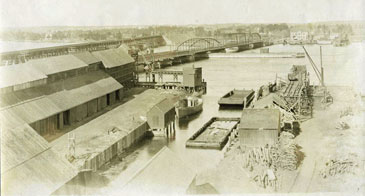 |
In February of 1836, a petition was brought forth to build a railroad through the town, "across the Pond to Greenleaf’s field, thence to cross Union, Titcomb, Market and Summer streets, thence across Merrimac street over the Newburyport Bridge." Nearby inhabitants strongly opposed the route. Amendments were made, and a final plan was approved for the railroad tracks to pass west of the Old Jail on Auburn Street and under High Street with a suitable tunnel. The track from Boston to Salem was completed in 1838 and to Newburyport in 1840.
In March of 1840, the Eastern Railroad Company purchased the bridge and erected a new passage with two road beds, one above the other, to accommodate both the railroad on the upper road and carriages and foot passengers on the lower road. By June of the same year, the Eastern Railroad Company offered three round trips daily to Boston, and in October the first train traveled over the Newburyport Salisbury Bridge to northern destinations.
Looking south from the Merrimack River railroad bridge. Large building on left is the Dodge Shoe Factory. Courtesy of the Newburyport Public Library Archival Center.
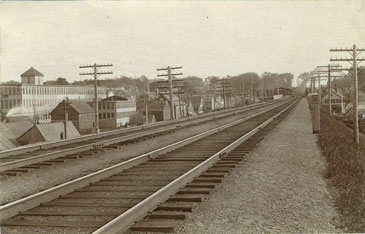 |
Due to the strain of the frequent passenger and freight trains, a new railroad bed just upriver of the bridge was completed in 1866, covering the approximate area where the railroad trestle stands today. During the next forty years the bridge was replaced three times, incorporating a draw for boat traffic. Up until 1840, large vessels launched from shipyards on Merrimac Street had no worries about being able to pass under a bridge. The first bridge did not include a draw in the bridge for the convenience of vessels passing through, but a draw was finally completed several years later.
[return to top of page]
Cotton Mills
Merrimac Street view looking towards railroad bridge and Pearson’s Bakery on right, circa 1900. Courtesy of the Newburyport Public Library Archival Center.
 |
In 1835, at the foot of Strong Street "on the wharf above the Newburyport Bridge," the Newburyport Steam Cotton Company was incorporated "for the purpose of manufacturing cotton," one of the first in Newburyport. The Newburyport Herald of March 4, 1836, reports that a structure was completed measuring one hundred and thirteen feet long, forty feet wide and three stories high to house the machines and equipment. A forty-horsepower steam engine was purchased to drive three thousand spindles. Stephen W. Marston was elected president and William Balch and Tristam Coffin, Jr. named as directors. The land was sold in 1843 Essex County, and the company dissolved. The Essex Steam Mills Corporation purchased the factory and manufactured cotton cloth from 1844 until 1856, when the building was destroyed by fire. The mill employed over 130 men and women and manufactured 1,700,000 yards of cotton annually.
[return to top of page]
Pearson’s Bakery
In 1792, Joseph Pearson Sr. of Newburyport opened Pearson’s Bakery and early on invented the hardtack biscuit that was supplied to ships leaving port and sailing all over the world. Joseph's sons Harris, John Jr., and Theodore joined the business and kept locations on Lime, Center, Water, and Merrimac Streets. In the early 1800s, John Sr. started bakeries in Portsmouth and Exeter, New Hampshire, while maintaining shops here. He eventually returned to assume management of the popular Newburyport bakery. John Jr. originated the cream biscuit that also became very popular. In addition to local business and the ship provision business, the bakery sold goods to hotels along the East Coast.
View looking towards river with railroad tracks to right. Pearson’s Bakery, later know as the National Biscuit Company. Courtesy of the Newburyport Public Library Archival Center.
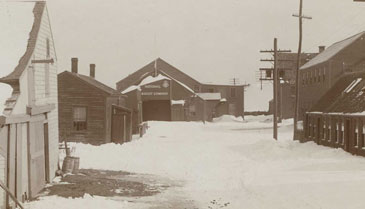 |
In 1890 Pearson and Sons merged with another bakery and became known as the New York Biscuit Company. Six years later, the New York Biscuit group joined several dozen others and was renamed the National Biscuit Company. The last location of this successful bakery was Pearson’s Wharf, now the River’s Edge condominium complex along the railroad tracks. In the 1950s, another name change took place, one recognizable to most people today: the new name was Nabisco. Its favorite products still include Oreo cookies, Ritz crackers, and an old favorite of New Englanders - Crown Pilot crackers.
John Pearson Jr.’s grandson, Edmund L. Pearson, a native of Newburyport, became one of America’s foremost true crime writers. He attended Harvard University and went on to work in New York City, choosing a career as a librarian at the New York Public Library. Mr. Pearson wrote over eighty essays, many of them published as books.
[return to top of page]
|
E. P. Dodge Shoe Manufacturing
Looking north at the foot of Summer Street and Merrimac Streets. Railroad depot on left and the E. P. Dodge Shoe Company in the center. Courtesy of the Newburyport Public Library Archival Center.
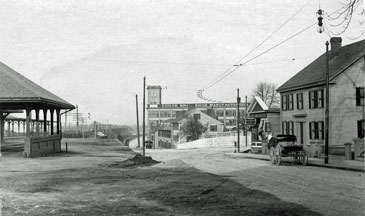 |
Elisha Perkins Dodge (1847-1902) was born in Ipswich, Massachusetts and learned the shoe trade from his older brothers. Mr. Dodge settled in Newburyport in 1867, and at the age of twenty, he began to manufacture ladies’ shoes on Pleasant Street. Mr. Dodge had thirty employees and generated a profit of $5,000 in the first year of his enterprise. During the next twenty-two years, Mr. Dodge added buildings and additions to accommodate his growing business on Pleasant Street, Merrimac Street, and Tracy and Prince Places. He served as the twenty-fourth Newburyport mayor from 1890 to 1891. Mr. Dodge’s shoe business became the largest manufacturers of women’s shoes and boots in the United States. His family members included a son, Edwin Sherrill Dodge, the architect of Newburyport High School and the Ellen T. Brown Chapel at Oak Hill Cemetery. The five-storey wooden structure of the Dodge Shoe Company on Merrimac Street was destroyed in the Great Fire of 1934.
[return to top of page]
Albert Russell and Sons Foundry
Albert Russell (1811-1891) was born in Bath, Maine, and learned the brick-making business from his father. As a young man he traveled south and worked on flatboats on the Mississippi River before returning to New England where he learned the iron-molding business. Mr. Russell arrived in Newburyport in 1840 and established one of the first foundries in Essex County, located at the foot of Green Street at Brown’s Wharf. In 1860, Mr. Russell purchased the Homes and Nichols foundry and machine shop on Merrimac Street and relocated his business there with his two sons, Edward P. and Albert, Jr. Their business supplied iron castings for ships, as well as cooking stoves and an extensive line of machinery and marine specialties, of which the Russell frictionless pump was the most notable and popular item.
On the right, the Albert Russell and Sons Foundry and Machine Works located between Strong and Boardman on Merrimac Street. Courtesy of the Newburyport Public Library Archival Center.
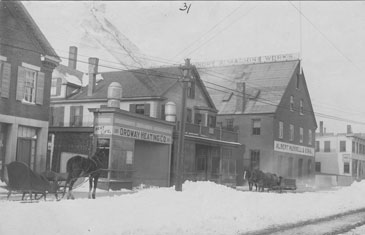 |
Another area of expertise of the Russell Foundry was iron fences, which it made to order for the Belleville Cemetery, the Kelley School, and the Newburyport Public Library. It also constructed the iron front for the new post office on the corner of Threadneedle Alley and State Street, all in the 1870s. In addition, over 350 Grand Army of the Republic iron markers, "GAR, Post 49," were made for local cemeteries in the early 1880s. The company’s skilled workers were honored to create a tablet that was erected at the battlefield of Gettysburg in memory of the Union brigade that took part in the Civil War. The Russell Foundry served the Newburyport community for sixty-five years.
[return to top of page]
Great Fire of 1934
After midnight, on May 19, 1934, two alarms sounded for a fire that nearly destroyed the downtown area. Over 100 fires started on Merrimac, Winter, Market, State, Unicorn, and Pleasant Streets destroying dozens of businesses and dwellings. The estimated loss was one million dollars.
The Newburyport Daily News of October 23, 2010, published the recollections of John Lagoulis, who lived on Unicorn Street, now the location of the Green Street parking lot, about the Great Fire of 1934: "During that devastating fire, all the families living in the Merrimac Street area from the bridge to Market Square, including the downtown areas, were awake throughout the night into daylight hours. Every family in the Market Square area was fighting the fire with their bare hands, trying to save their homes and families. I was there. I, too, was fighting that fire, carrying buckets of water up to our roof. We lived at 14 Unicorn Street
Looking east towards Merrimac Street and downtown shows the devastation of the fire of 1934. City Hall and the Unitarian church steeple seen on right. Courtesy of the Newburyport Public Library Archival Center.
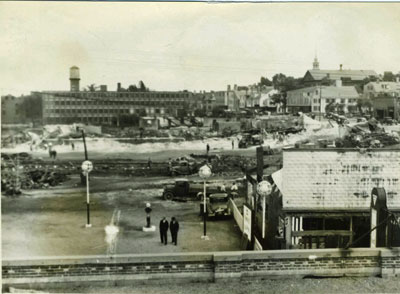 |
"My parents, sisters and brother and I climbed up to the roof and opened the skylight. We positioned my brother there. Our roof was on fire. Quickly, my parents, sisters and I each filled and carried large buckets of water up to my brother. As we handed him each bucket, he would climb through the skylight and throw the bucket of water onto the burning embers that were landing on and igniting our roof.
As fast as the roof ignited, we put the flames out with our buckets of water. My family was very fortunate to have an old-fashioned hand pump that was connected to a well in the sink of our kitchen. We kept pumping that well water into our buckets, running back and forth from the kitchen downstairs to the skylight upstairs all night long, keeping the fire from spreading on our roof. My parents, sisters, brother and I worked all night long until day break, until it was safe to stop. We were physically exhausted.
Support came from all surrounding cities and towns and even from New Hampshire. The fire departments worked all night long and were exhausted. It was a confusing and terrible night, a night of destruction. At day break, everything was burnt and black and dirty and smoldering with soot and the smoke was still rising. People stayed in their homes, exhausted. The streets were empty and dark."
[return to top of page]
|
Three Steeples and City Hall
Looking east towards the downtown skyline, three steeples and the roofline of City Hall appear from left to right: First Religious Society, Unitarian Church, City Hall, Baptist Church, and the North Congregational Church, Central Congregational Church.
View from left to right: Unitarian Church steeple behind City Hall, Baptist Church steeple, and the Central Congregational Church steeple.
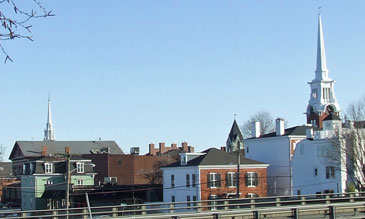 |
First Religious Society, Unitarian Church
Built in 1801, the First Religious Society was initially known as the Third Parish Church, located in Market Square and the first church in the waterside district, later known as Newburyport. The meetinghouse was built in 1725 and led by the young Reverend John Lowell (1704-1767). For seventy-six years the church had overlooked the waterfront and the growing industry of shipbuilding. It had become a welcomed landmark for sailors returning from long voyages and a center for a growing market of vendors and businesses. Patriotic gatherings filled the meetinghouse, and soldiers going to war marched by it.
Pleasant Street and the First Religious Society, Unitarian Church. Courtesy of the Newburyport Public Library Archival Center.
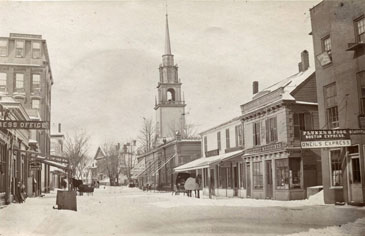 |
As the congregation grew and Market Square became a busy commercial district, a committee chose an area known as the Rock Lot, the land nearly covered by a rock ledge, on the newly laid-out Pleasant Street to build a new meetinghouse. Only the organ, bell, clock, and weathercock were moved to the new building, which was completed in 1801. The Society was still the leading one in town with a membership of 1,800 in 1808. By 1825, the meetinghouse was known as the Unitarian Church, the only one of its denomination in town.
City Hall
Looking west towards railroad tracks is Brown Square, the North Church or Central Congregational Church, and the City Hall roof, right center. Courtesy of the Newburyport Public Library Archival Center.
 |
At the old Town Hall in Market Square a meeting was held on March 19, 1850, and citizens voted to build a City Hall, the cost of which was not to exceed $30,000. The vote was close: 118 votes for the new location on the corner of Pleasant and Green Streets, and 108 votes against this proposal. A building committee was formed, land purchased, and the cornerstone laid on July 4, 1850. The new structure was designed by local architect and Civil War veteran Colonel Frederick J. Coffin, who also drafted the plan for the Ocean Steam Mill on Warren Street. Completed in February of 1851, Albert Currier, a well-known contractor who served as Newburyport mayor in 1859 and 1860, built the City Hall as well as the Immaculate Conception Church and the public library Simpson annex. According to the Newburyport Historic Building Survey, the City Hall is an "excellent example of the Italianate style." Newburyport officially became a city in 1851, and the first mayor was Caleb Cushing, who went on to become a well-known advisor to presidents, the first U. S. envoy to China, minister to Spain, and advisor to presidents of the United States.
Baptist Church
In 1804 the first Baptist Church was founded. A small group led by Reverend Joshua Chase met in Joppa, the South End neighborhood of Newburyport, in a small schoolhouse on Marlboro Street. By May of 1805 regular sermons were being preached at the schoolhouse and in a small building at the "Plains" in the North End of town by Reverend John Peak. A central location was later chosen, and members met in a structure called the "Tabernacle" on Temple Street. In 1809, a new brick structure was completed on Liberty Street, but less than two years later the Baptist meetinghouse and pastor’s dwelling was destroyed in the Great Fire of 1811. Within a short time $4,000 was collected to build a new church on Congress Street near Kent and Washington Streets.
In 1874, looking west on Pleasant Street with the Baptist Church steeple on left and the North Church steeple on right. Courtesy of the Newburyport Public Library Archival Center.
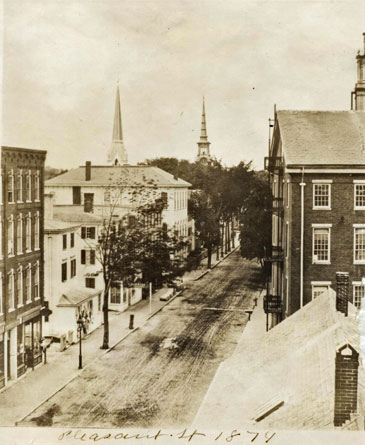 |
During the period of construction, the Baptists met at the courthouse on Bartlet Mall. Philosophical disagreements soon followed, and a few of the parishioners left to form the Green Street Baptist Church. Its new structure was designed by local architect Frederick J. Coffin. In 1869 the Congress Street Church merged with the Green Street Baptist Church and was renamed the Central Baptist Society of Newburyport. The Baptist community moved to a new inter-denominational church, the Hope Community Center on Hale Street, in the 1990s. The Baptist church building has been renovated and converted to a restaurant and function room.
North Congregational Church, Central Congregational Church
In 1768, Enoch Titcomb sold some of his land, on which the first of three meetinghouses of the Second Congregational Society was erected. A group of parishioners left the Third Parish Church in Market Square and established their meetinghouse on Titcomb Street, soon known as the North Congregational Church. The original wooden building with a bell and clock faced the river. Due to age, the old meetinghouse was razed and a new one constructed facing Brown Square. This building was destroyed by fire in 1861, and the new brick meetinghouse still stands today. In 1909, two churches merged with the North Church: the Prospect Street Church and the Whitefield Congregational Church on State Street, and parishioners agreed on a new name – the Central Congregational Church.
Portrait of Reverend Luther Dimmick. Courtesy of the Historical Society of Old Newbury.
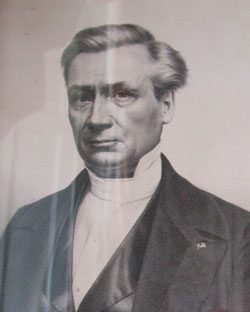 |
Dr. Luther F. Dimmick (1790-1860) served for forty-one years as pastor of the North Congregational Church. In 1830, Reverend Dimmick welcomed writer and Abolitionist William Lloyd Garrison, a Newburyport native, to the North Church. The young William at age thirteen was apprenticed to Ephraim Allen, the owner of the Newburyport Herald, and learned the newspaper trade for the next seven years, an experience that helped to shape his life.
Mr. Garrison addressed a large audience on the subject of slavery, but when it was announced that he would speak again the next evening, there was so much unrest in the community that the doors of the meetinghouse were closed against him. In the Newburyport Herald edition of October 1, 1830, Mr. Garrison complained of the "unkind and uncivil treatment" he had received from his former friends and townsmen. He returned to Boston to work on the first edition of his publication, The Liberator. Mr. Garrison went on to dedicate his life to the freedom of speech and the press, the Abolitionist movement, women’s rights, and social reform for equal rights for all.
[return to top of page]
|
Joseph Atkins
Joseph Atkins (1680-1773) and his family lived at 9 Strong Street. Mr. Atkins, a native of England, traveled with his family to Newbury from the Isle of Wight in about 1725. Mr. Atkins purchased a lot of land from the Merrimack River up Strong Street to the land now called Washington Street over to Queen Street, now Market Street. He became a wealthy merchant involved in the West Indies trade and was active in both church and community. In 1738, Mr. Atkins and business partners purchased land at the foot of Market Street to build a wharf. Here several warehouses and a distillery were constructed.
Portraits of Mr. and Mrs. Joseph Atkins. Courtesy of the Historical Society of Old Newbury.
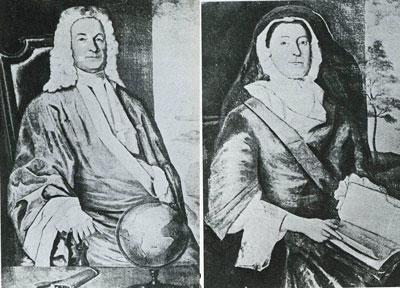 |
It was Joseph Atkins who first suggested the construction of a church to accommodate the people at the "waterside" of Newbury. He purchased and donated the land St. Paul’s Church now occupies. With other merchants and sea captains, Mr. Atkins raised by subscription the money for the building that became St. Paul’s Chapel in 1741. Mr. Atkins served as a vestryman, warden, and generous benefactor of the church.
The first Mrs. Atkins died within several years of their living in what was then still Newbury. Mr. Atkins’s second wife, Mary Dudley Wainwright, was the daughter and granddaughter of governors of the Massachusetts Colony. Mr. and Mrs. Atkins's portraits are on display at the Cushing Museum, the Historical Society of Old Newbury.
[return to top of page]
Joseph Wilson
Joseph Wilson (1779-1857) and his family lived at 12 Strong Street where his woodworking skills can still be seen decorating the doorway. Mr. Wilson was born in Marblehead, Massachusetts, and came to Newburyport in 1798. At a young age Mr. Wilson became a sought-after wood carver of ship figureheads. Maritime merchants paid up to five hundred dollars to have his figureheads adorn the bows of the hundreds of ships being built along the Merrimack River. Mr. Wilson was also commissioned to decorate other parts of seagoing vessels with his art: sterns, railings, and cabins were adorned with carved trim, scrolls, wreaths, and sculptures of the ship’s owner or namesake that bore his mark.
Advertisement in the City Directory, 1873. Courtesy of the Newburyport Public Library Archival Center.
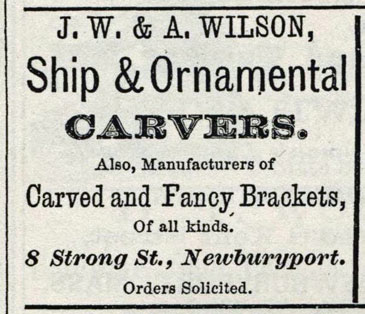 |
Mr. Wilson’s work attracted the attention of Timothy Dexter, the eccentric entrepreneur who had purchased the mansion at 241 High Street. For seven years, Mr. Wilson worked at carving statues of well-known politicians such as Jefferson, Washington, and Adams in front of Dexter's mansion. Mr. Dexter placed over forty carved statues of political figures on the grounds of his estate and atop its fencing. Most of them were destroyed in the hurricane of 1815. One statue and pieces of another can be viewed at the Historical Society of Old Newbury. Mr. Wilson was commissioned by St. Paul’s Episcopal Church to carve a wooden finial in the shape of a bishop’s mitre that was placed on top of the church’s steeple, in honor of Edward Bass (1726-1803), a rector of St. Paul’s for fifty-one years and the first American Episcopal Bishop of Massachusetts. The mitre was saved from the fire of 1920 that destroyed the St. Paul’s Church and is now located in the church alcove.
[return to top of page]
Tracy’s Ropewalk
In 1764, when Newburyport was incorporated, there were three shipyards, the Lower shipyard at the foot of King Street, now Federal Street, the Middle shipyard near Market Square, and the Upper shipyard at the foot of Queen Street, later Market Street. Cordage and line were needed for the outfitting of vessels, and there were at least two ropewalks at this time. John Crocker’s at the Frog Pond, where the courthouse now stands, and John Tracy’s near the Quaker Burying Ground. Mr. Tracy’s ropewalk stood between Winter and Boardman Streets before Washington Street was laid out. At this time almost fifty hands produced from two to three hundred tons of white lines and tarred cordage annually.
A bill-head for John Tracy’s rope yard. History of Newburyport, John J. Currier.
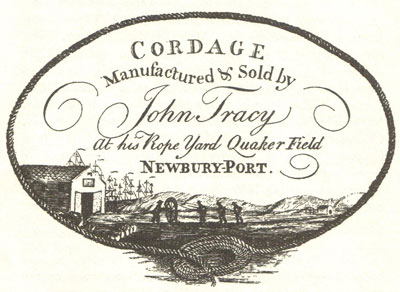 |
The shipbuilding industry was dependent on rope for rigging, fishing, and anchor and towing lines. The length of the rope was dependent on the length of "the walk" or actual building; some measured 175 to 300 yards long. Piles of fibers were spun into threads or yarns. Next, the yarns were twisted together to form rope. While walking the length of the building, the twisting had to be done in a straight line. Strands were fully extended together with a steady tension applied to the whole length to complete the final rope product.
During the next 100 years, there were numerous ropewalk businesses in the area located in the South End of Newburyport, whose artisans were known all over the United States for their skill in rope-making. In the Newburyport Herald of February 2, 1865, an article discussed the skilled men of the local ropewalk: "We miss the old ropewalks that used to run from Bromfield Street to Marlboro, with one, Smith’s below. The one hundred men and boys who served an apprenticeship in these ropewalks are plying their trade in all parts of the country and the rope makers were sent as far as India and to superintend the Imperial ropewalks in Russia."
[return to top of page]
|
Quaker Cemetery
There were two known Quaker family cemeteries during the early days of Newburyport. One was located on Washington Street and the other on High Street. A Quaker Society of Friends group stopped at Newbury in the 1600s on their way farther north to New Hampshire and Maine. One contingent established themselves nearby in Hampton, New Hampshire, as early as the 1690s. Records show that the Society of Friends was not a welcomed group, and locals were fined for entertaining Quakers at their homes. In 1716, the church on Pipestave Hill, later part of West Newbury, kept a day of humiliation and prayer to petition that would "prevent the spread of errors in the place, especially the error of quakers."
West Newbury Quaker Meetinghouse on Turkey Hill Road razed in 1917. Courtesy of the West Newbury Historical Commission.
 |
By 1705 a Quaker meetinghouse had been erected in Salisbury, later Amesbury, Massachusetts, to accommodate the growing congregation in the area. Meetings were held in Newbury in private homes until a local society was formed. In the summer of 1744 the group erected a meetinghouse. The structure was on the south side of the country road, later High Street, in an area located opposite the Fourth Parish Meetinghouse, later known as the Belleville Congregational Church. A few members of the Sawyer Quaker family were buried here on top of the hill, and gravestones could still be seen until the early 1900s. The meetinghouse was a simple plain structure about thirty feet wide, forty feet long, and two stories high. The Coker family and other members of the Society lived in the area of John Tracy’s Ropewalk. Family members were interred here, and their gravestones remained visible at least until the early 1900s. Over the past century private owners have encroached on the land of the old burying ground.
In 1823, the Society sold the land and meetinghouse on High Street and joined the West Newbury Quakers on Turkey Hill Road in West Newbury. In 1855, one acre of land was purchased near the meetinghouse for a burying ground. The cemetery is still visible today situated along the Artichoke Reservoir. The old Newburyport meetinghouse was used as a school taught by "Miss Upham," who announced in 1825 that "The French and Italian languages, Painting and other branches of Education usual in Female Seminaries," would be taught there. Several years later the meetinghouse was used as a vestry for the Belleville Church. The Quaker house was eventually relocated and still stands at 36 Ferry Road.
[return to top of page]
Washington Street and the Route One Bypass
Washington Street looking towards railroad crossing. Courtesy of the Newburyport Public Library Archival Center.
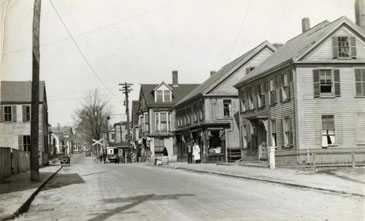 |
Route One construction of the Washington Street overpass. Courtesy of the Newburyport Public Library Archival Center.
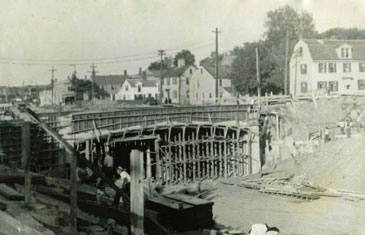 |
Washington Street from Green Street to Market Street was laid out in 1782. Washington Street continued to Winter Street in 1839, then past Boardman Street twelve years later. It was finally completed in 1861, ending at Kent Street.
In 1930, the controversial Route One bypass that would destroy thousands of dollars worth of taxable property to create the new highway was begun. Houses on Winter, Summer, High, Vernon, and Railroad Streets were demolished for the bypass to eliminate the traffic on High and State Streets, except for a few homes that were moved to nearby neighborhoods. State Street had become such a busy thoroughfare for journeys to southern and northern destinations that police had to direct traffic that clogged the downtown area and Market Square. The new rotary at the intersection of Parker and State Streets redirected traffic via a bypass between Winter and Summer Streets and over the Newburyport Salisbury Bridge. The bypass was completed in 1934.
[return to top of page]
|
Moseley House
Looking from Washington Street, the railroad tracks pass under the High Street overpass. Courtesy of the Newburyport Public Library Archival Center.
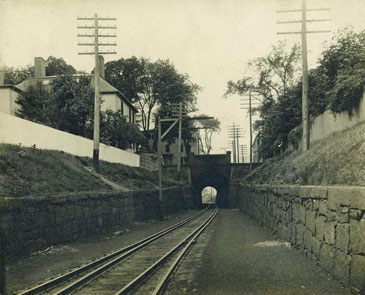 |
In 1819, Ebenezer Moseley (1781-1854) purchased Abner Wood’s dwelling, and for years lineal descendants occupied the home. The house is 180 High Street, on the west side of the High Street overpass overlooking the railroad tracks. Mr. Moseley, son of Colonel Ebenezer and Martha Strong Moseley, was born in Windham, Connecticut. Father Colonel Moseley attended Yale University, was an ordained minister, and fought in the Battle of Bunker Hill. Ebenezer moved to Newburyport in 1805 and opened a law office that soon became a very large and lucrative business. A young Caleb Cushing, Newburyport’s first mayor, was one of many law students who studied under Mr. Moseley.
Mr. Moseley was chosen to receive President James Munroe on his visit to Newburyport in 1817 and also gave the address in 1824 welcoming General Marquis de Lafayette, who stayed at the old Tracy Mansion, now the public library. Mr. Moseley’s son, Edward S., describes his father as having integrity, sound judgment, a love of gardening, and love especially for his children: "Always affectionate in the family, he delighted to contribute to the reasonable pleasures of his children, so that by some he was thought too indulgent. He had in him a vein of humor, and a laugh when he gave vent to it, which was magnetic."
Portrait of Ebenezer Moseley. History of Newburyport. John J. Currier.
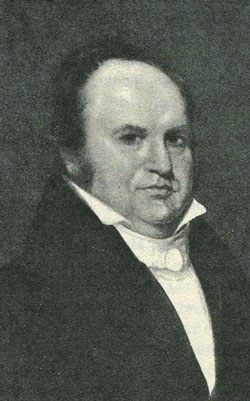 |
Looking north towards the High Street overpass and the railroad tunnel. Courtesy of the Newburyport Public Library Archival Center.
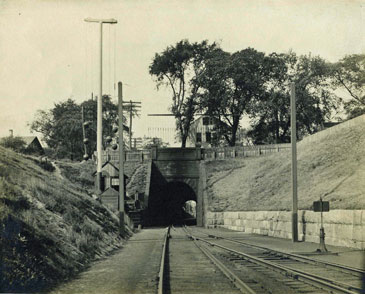 |
Edward Strong Moseley (1813-1900) inherited a love of gardening from his father, who had taught him as a child how to nurture tree seedlings to plant on High Street. Mr. Moseley became one of the original incorporators and designers in 1842 of the State Street Oak Hill, one of the first rural garden cemeteries in America.
The young Edward attended local schools, Governor Dummer Academy (now The Governor’s Academy) and Phillips Andover Academy, before attending Yale University. He joined the firm of the successful Boston merchant Benjamin A. Gould, whose sister, Hannah F. Gould, was a well-known Newburyport poet. In Mr. Gould’s employment, Mr. Moseley traveled to China, South Africa, and India, learning the shipping and trade business. By the late 1830s, Mr. Moseley had returned to Newburyport. Over the next sixty years he became one of the most respected, benevolent, and wealthiest men in the community.
Portrait of Edward S. Moseley. Courtesy of the Newburyport Public Library Archival Center.
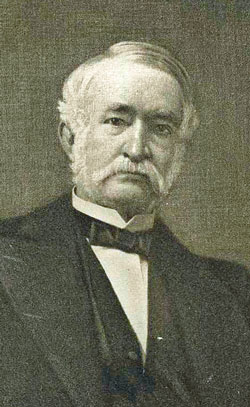 |
Edward Moseley began purchasing land along the Merrimack River in the 1860s. From the 1890s to the 1950s, his son Frederick C. and family members lived there at what was known as the Moseley Estates. It is now Maudslay State Park.
[return to top of page]
Guinea Village
Intersection of Pond and Auburn Streets before Route One construction. Railroad tracks in background. Courtesy of the Newburyport Public Library Archival Center.
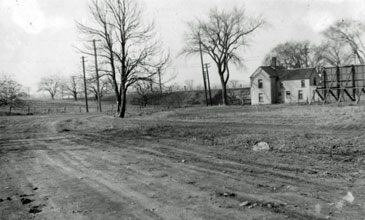 |
Sarah Smith Emery (1787-1879) in Reminiscences of a nonagenarian, "Back of the Pond stood a collection of low, unpainted huts. This village was styled 'Guinea.' Here were the homes of the colored population, of which there was quite a number. These were mostly descendants of servants formerly held as slaves in our first households. Many considering themselves as still connected with the old master’s family, in any emergency always looked to it for advice, care and consideration."
Old Guinea Bridge, torn down in 1981. Courtesy of the Newburyport Public Library Archival Center.
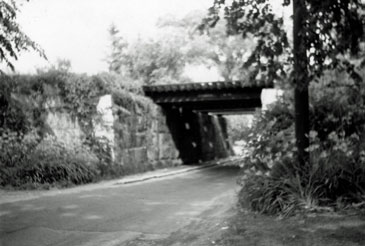 |
African Americans lived along Auburn Street that connected to Low Street. The bridge over Low Street was completed for the railroad in 1840. As tradition asserts, the little village and bridge was known as Guinea, the namesake of some of the African Americans' ancestral homeland of Western Africa and the country of Guinea. Other black Newburyporters lived throughout the town. Peter Romily, a restaurant owner, and Civil War veteran George C. Gray, a cook and coffee house proprietor, lived on Market Street with their families. Mrs. Celia Ann Dickson, a former slave in Virginia, lived on Titcomb Street and managed a boarding house. Civil War veteran Edward Moses, born a slave on a Georgia plantation, lived on Cherry Street and worked for a well-known Newburyport photographer John Winter Winder and contractor John A. Greely, brother of Arctic explorer Adolphus Greely. Lucy Lancaster nursed residents during the 1796 yellow fever epidemic and gained respect from townspeople including the wealthiest and most influential citizens for her skilled care.
[return to top of page]
|
|
|

 Copyright © 2012, Newburyport Clipper Heritage Trail. All rights reserved.
Copyright © 2012, Newburyport Clipper Heritage Trail. All rights reserved.

 Copyright © 2012, Newburyport Clipper Heritage Trail. All rights reserved.
Copyright © 2012, Newburyport Clipper Heritage Trail. All rights reserved.